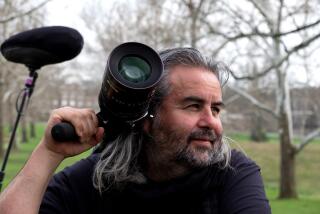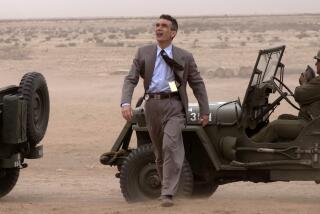Zapruder Film Coming Soon to Home Theaters
- Share via
One of the most tragic and disturbing moments of American history can soon be yours to watch and review in your own home.
Next week, the public will be able to purchase for the first time on video an authorized, newly restored copy of one of this century’s most infamous film sequences, the home movie footage of President John F. Kennedy’s assassination.
“Image of an Assassination: A New Look at the Zapruder Film,” which will retail for $19.98, climaxes with a newly digitized color version of the 26-second, 500-frame film that boasts unprecedented clarity and includes an estimated 64% more visual information.
A digital video disc edition, to be released later this month for $24.98 retail, will contain capabilities allowing a frame-by-frame analysis of the Zapruder film. The video will be sold by major retailers.
Produced by MPI Home Video of Orland Park, Ill., this 45-minute documentary traces the history of the seminal footage captured on Nov. 22, 1963, by Dallas dress manufacturer Abraham Zapruder, who died of cancer in 1970, as well as the painstaking restoration process.
Since 1978, the original 8-millimeter Zapruder film has, at the request of his family, been granted “courtesy storage” at the National Archives. The restoration of the film, which began last year, was initiated and coordinated by LMH Co., which was formed by Zapruder’s wife, Lillian, and their children, Myrna and Henry. It’s the first time since the assassination that a copy has been made from the original.
“We began looking at ways to properly archive the original film,” said LMH spokesman James Lorin Silverberg. “The concern was that stored even under the best conditions, 8-millimeter film is subject to deterioration.” The video documentary notes that previous archival efforts had resulted in damage to the film.
*
Advances in digital technology addressed this issue. McCrone Associates of Westmont, Ill., a scientific and consulting firm that analyzed the Shroud of Turin, photographed each frame of the Zapruder film. These were made into 4-by-5 transparencies. The enlarged format preserved visual information between the sprocket holes heretofore not seen by the public.
Chicago-based There TV, a film and television post-production house, reanimated the still frames. “We had to buy an extra safe to house the transparencies and preserve the ‘absolute secrecy’ of the project,” said digital animator Todd Murphy. “We didn’t talk much about it.”
The challenge, he said, was to “make the movie play as a cohesive piece. Motion tracing eliminated some of the hand-held shakiness. But we didn’t do a whole bunch of fix-up work. This is the film, warts and all. We didn’t want to stir the brew of conspiracy theorists.”
Viewing the footage frame by frame, Murphy said, he was struck that most of the crowd is “unaware of the history happening at that moment. It looks like footage from any other event until you look a little closer and you see the very graphic facial expressions. There is a lot of shock and humanity in those frames.”
The Zapruder family has been caught in a dispute with the federal government concerning the film, one of the most important visual documents of this century. (An archival copy has been enshrined in the National Film Registry in the Library of Congress.)
Footage of the ghastly scene thrust Zapruder, described on the video as “an unassuming man,” into the national spotlight. Forty-five minutes after Kennedy was declared dead, Zapruder was interviewed live on Dallas TV. The film became the basis for any number of conspiracy theories by those who believe Lee Harvey Oswald was not the sole gunman.
(Last year the Assassination Record Review Board ruled that the original film should be part of its permanent records. There have been ongoing negotiations since then over how much compensation the family--which maintains copyrights to the film--should receive from the government.)
Authorizing the video, Silverberg emphasized, was “a difficult decision” for the Zapruders. “The family has never been interested in commercially exploiting the material,” he said. “But there has also been criticism that not only has the material been [widely] unavailable to the public, but that researchers have been frustrated working from [poor-quality] copies.”
Enter MPI. Based in Orland Park, Ill., MPI, now in its 20th year, was in some ways a surprising choice to become involved in distributing the video. MPI is popularly known as the distributors of “A Hard Day’s Night,” “McLintock!,” the so-called “Lost Honeymooners” episodes and the gothic soap opera “Dark Shadows,” the company’s bestseller.
But the Zapruder documentary is actually a return to the company’s roots in producing and distributing nonfiction programming. The company’s vast archive of historical footage includes the WPA Film Library and the British Pathe collection. “This is a labor of truth,” said MPI president and founder Waleed B. Ali. “I wanted to tell the story of the Zapruder film. It is one of the most important pieces of film ever shot.’
The Chicago South Side native was living on the West Bank of what was then Jordan at the time of the assassination. “When we woke up that morning,” he recalled, “my father was slapping his face, repeating, ‘Kennedy’s dead, Kennedy’s dead.’ ”
MPI initially contacted LMH about the project in the early ‘90s, but at that point the family was not interested, according to Silverberg. The technology to create this “accurate reference copy” paved the way for LMH to authorize the video release. “MPI is a leader in the dissemination of nonfiction video,” Silverberg noted. “We felt they could do this in a responsible way.”
Ali estimates that the project has cost upward of $500,000. “It’s risky, not a slam dunk.”
But, he added, “This may end up being the most important title in our catalog. You never know. Some 14-year-old student could watch this enough times and discover something nobody else has seen.”
More to Read
Only good movies
Get the Indie Focus newsletter, Mark Olsen's weekly guide to the world of cinema.
You may occasionally receive promotional content from the Los Angeles Times.









